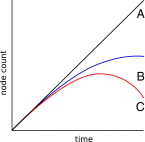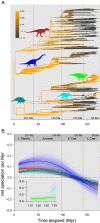Dinosaurs in decline tens of millions of years before their final extinction
- PMID: 27092007
- PMCID: PMC4983840
- DOI: 10.1073/pnas.1521478113
Dinosaurs in decline tens of millions of years before their final extinction
Abstract
Whether dinosaurs were in a long-term decline or whether they were reigning strong right up to their final disappearance at the Cretaceous-Paleogene (K-Pg) mass extinction event 66 Mya has been debated for decades with no clear resolution. The dispute has continued unresolved because of a lack of statistical rigor and appropriate evolutionary framework. Here, for the first time to our knowledge, we apply a Bayesian phylogenetic approach to model the evolutionary dynamics of speciation and extinction through time in Mesozoic dinosaurs, properly taking account of previously ignored statistical violations. We find overwhelming support for a long-term decline across all dinosaurs and within all three dinosaurian subclades (Ornithischia, Sauropodomorpha, and Theropoda), where speciation rate slowed down through time and was ultimately exceeded by extinction rate tens of millions of years before the K-Pg boundary. The only exceptions to this general pattern are the morphologically specialized herbivores, the Hadrosauriformes and Ceratopsidae, which show rapid species proliferations throughout the Late Cretaceous instead. Our results highlight that, despite some heterogeneity in speciation dynamics, dinosaurs showed a marked reduction in their ability to replace extinct species with new ones, making them vulnerable to extinction and unable to respond quickly to and recover from the final catastrophic event.
Keywords: Bayesian methods; dinosaurs; evolution; phylogeny; speciation.
Conflict of interest statement
The authors declare no conflict of interest.
Figures



References
-
- Sloan RE, Rigby JK, Jr, VAN Valen LM, Gabriel D. Gradual dinosaur extinction and simultaneous ungulate radiation in the hell creek formation. Science. 1986;232(4750):629–633. - PubMed
-
- Sarjeant WAS, Currie PJ. The “Great Extinction” that never happened: The demise of the dinosaurs considered. Can J Earth Sci. 2001;38(2):239–247.
-
- Fastovsky DE, et al. Shape of Mesozoic dinosaur richness. Geology. 2004;32(10):877–880.
-
- Sullivan RM. The shape of Mesozoic dinosaur richness: A reassessment. N M Museum Natural Hist Sci Bull. 2006;35:403–405.
Publication types
MeSH terms
LinkOut - more resources
Full Text Sources
Other Literature Sources
Molecular Biology Databases

